
Sostituzione scheda madre MacBook Air 13" metà 2013
Introduzione
Vai al passo 1Segui questa guida per sostituire la scheda madre.
Cosa ti serve
Ricambi
Strumenti
Mostra di più…
-
-
Usa un cacciavite P5 Pentalobe per rimuovere le dieci viti che tengono in posizione il case inferiore, delle seguenti lunghezze:
-
Due viti da 9 mm
-
Otto viti da 2,6 mm
-
-
-
Inserisci le tue dita tra il display e il case inferiore e tira verso l'alto per separare il case inferiore dal MacBook Air.
-
Rimuovi il case inferiore e mettilo da parte.
There is a nub on the inside of the case which is attached to the battery. When you try to pull it open, it appears to be attached to the plastic casing of the battery, which sometimes splits. I gently unhooked the nub from the battery before removing the case fully. This seems to happen if the battery has suffered some drop damage (plastic parts broken around screws and parts of plastic frame split). Just an FYI in case your lower case doesn't pull away easily.
To add - the slim 1cm tab “nub” is on the centre of the back cover & fits into a hole in the battery frame. I ran my fingers around the whole of the cover to eventually here it click out.
nijafe -
So this is a legit back cover for MacBook Air?
I bought the part and tools from iFixit and followed the directions. The mechanical part went smoothly - maybe 10 minutes to disassemble/replace/reassemble.
Getting Catalina (the current MacOS) to install was not working until I used Cmd-Opt-R (as noted in the OWC paper sheet that came in the box) which brought up the proper installer - I believe from a pre-prepared bootable SD card but it’s hard to say. From there the install succeeded taking ~1.5 hours.
Beware that (a) the install requires a working internet connection for verification and updates, and (b) the system must have been running at least macOs 10.13 (High Sierra) before the install in order to have an EFI BIOS that recognizes the SSD.
Thanks for the detailed photos. When repairing equipment, I don’t really like to disassemble plastic parts, they can be damaged, but your screenshots help a lot. For my studies, I am writing an essay comparing the reliability of laptops from various manufacturers and the complexity of their repair, maybe it will be useful for someone to check the essay for plagiarism here essay checker, when comparing different manufacturers, I understood why people love Apple so much. The minimum number of failures. Of course, repairing it in an official service is not cheap, but with the help of such detailed instructions, you can do it yourself and save a lot.
The screwdriver bit to use on these case screws is not named, but I found that my "CR-V 1.2" did the job nicely.
The driver for the screws inside the case are named, as "T5".
-
-
-
Afferra la piccola striscia di plastica trasparente attaccata al connettore della batteria e tirala parallelamente alla scheda verso il bordo anteriore dell'Air.
how does a person put the battery connector back in?- that is the only thing i’m afraid of touching after putting new fan in.
I found it was possible to put the battery connector back in as the last step, however having gone through that and found it to be a little challenging, I would actually recommend attaching the battery connector before screwing back in the bracket. That way you’ll put a lot less stress on the connector cable.
When you are plugging the connector back in, make sure to give it some extra pressure to make sure it is all the way in. It may look like it’s in but needs to be pushed harder!
After disconnecting the power, you may skip directly to step 18. I don’t know why someone would think it necessary to disconnect all the other stuff. There is no need whatsoever to do so. The more things you disconnect, the more things you risk damaging. Many of the parts in steps 4 through 17 are quite delicate, and easy damaged.
The screw in step 18 is easily accessed without removing even the rubber gasket. Regarding step 18, only remove the screw. (This screw is rather long, with long threads.)
It’s helpful to take photographs of this area before removing the screw, so you’ll know what it’s supposed to look like when you put it back together.
There are only 16 steps in this repair process. I wonder whether you are commenting on a different repair.
Gyandev -
What if your battery doesn’t have that clear tab?
Yep, exactly the issue that I have
Unscrew the battery first, then let the cable flex out a little. Use a spudger or small pick to push the connector out from the board.
Nathan -
Where can i buy the battery connector?
Macbook air 2015 battery connector where can I purchase?
-
-
-
Usa la parte piatta di uno spudger per sollevare il connettore del cavo della scheda I/O e scollegarlo dalla presa sulla scheda I/O.
When putting this back together, be careful you don’t flip I/O board cable. It will fit, but the computer will not work. You’ll know it’s wrong if it covers the fan.
-
-
-
Scolla delicatamente il cavo della scheda I/O dall'adesivo che le tiene fermo sopra la ventola.
the instructions should really indicate you’re only disconnecting one end of the cable. you disconnect the other end in step 6.
Bonjour,quand je retire la nappe de la carte E/S , l’éclairage de l’écran s’affiche mais quand je remets la nappe de la carte E/S ,j’ai un écran noir.J’attends votre réponse.Cordialement.
I literally did this wrong just like you warned not to! Very easy to do…
I watched the video twice and went really slowly through steps and it works!!! It was a little scary but we got through it! Thanks so much!!
20.00000.000$
-
-
-
Mentre tiri delicatamente il cavo vicino alla sua presa sulla scheda madre, usa la parte piatta di uno spudger per far leva su entrambi i lati del connettore alternandoli per muoverlo man mano verso l'alto e scollegarlo.
-
Rimuovi il cavo della scheda I/O.
pour le remontage
de mon coté tout c’est bien passé, il faut juste bien vérifier la nappe de la carte E/S soit à l’endroit, car sinon l’ordinateur refuse de démarrer ( se référer à la photo du coup )
-
-
-
Usa la punta di uno spudger per ruotare attentamente verso l'alto l'aletta di bloccaggio del connettore ZIF del cavo della ventola.
I did not find it necessary to loosed the retainer flap, unplug the ribbon cable from it's socket, or remove the fan. After removing the fan screws in Step 9, the fan was loose enough that it can be slightly moved to the side. I felt that loosening the retaining flap and removing the fan adds unnecessary potential to damage something. To the contrary, if you bump the fan while it's plugged in, you might damage the ribbon cable.
My retaining flap broke instantly when lifting up with the spudger. Is that normal or possible to fix?
Similar problem, but with the microphone flap. Did you manage to fix it or get it back in?
Edwin -
I've performed many repairs on 13" MacBook Airs ('MBA's), including two heat sink compound 're-dos' just today (on a 2014 13" and a 2015 13").
It is not necessary to remove the I/O Board to take out the heatsink. And I've done it both ways - its way easier if you leave the I/O board in place. Here's why: removing the I/O board requires dis -and re-connecting two extremely delicate connectors as well as several cables that are really tricky to get back in place, all critical connections. If you aren't experienced with this kind of work, its taxing.
Instead, once you remove the flat I/O cable, remove the 3 screws holding in the fan and the two hinge screws securing the antenna cable guide. Now the screw securing the tip of the 'radiator' end of the heat sink will be pretty easy to access. The detached fan can moved (and you don't need /want to move it much!) to disengage the rubber shroud where it goes under the fan and gently guide the 'radiator' out.
-
-
-
Svita le tre seguenti viti che fissano la ventola alla scocca superiore:
-
Una vite Torx T5 da 3,6 mm
-
Una vite Torx T5 da 2,7 mm
-
Una vite Torx T5 da 3,6 mm con la testa corta
I found it easier to do step 11 before this one.
During reassembly don’t forget the ribbon cable.
-
-
-
Solleva la ventola dalla parte della scheda I/O e tirala via dalla scocca superiore.
-
Rimuovere la ventola scollegherà anche il suo cavo a nastro. Stai attento a non strapparlo.
It is a lot easier to insert the flat ribbon in its socket before placing the fan back in place. BUT DO NOT YET FLIP BACK the retaining flap, until you have seated and screwed the fan. This way in case you pull on the fan by mistake, the flat ribbon is free to come out, otherwise you may tear it.
I did not find it necessary to remove the fan or unplug the ribbon cable from it's socket. After removing the fan screws, the fan was loose enough that it can be slightly moved to the side. I felt that loosening the retaining flap and removing the fan adds unnecessary potential to damage something. To the contrary, if you bump the fan while it's plugged in, you might damage the ribbon cable.
If you are careful with the ribbon cable, there is no need to remove it, the fan will swing out of the way enough. I applied a small amount of sticky tape over the connector to keep it in place, just in case!
-
-
-
Scollega la scheda I/O tirando il suo cavo d'alimentazione via dalla sua presa sulla scheda madre.
It requires a somewhat concerning amount of force. I mean, be careful, but I pulled just slightly more than I was comfortable with (for the first time)
-
-
-
Usa la parte piatta di uno spudger per fare leva verso l'alto sul connettore del cavo dell'altoparlante per scollegarlo dalla sua presa sulla scheda I/O.
Steps 12 through 16 are not really necessary; you can easily de-route the necessary cables without removing the I/O board. Likewise with reassembly.
-
-
-
Usa la punta di uno spudger per ruotare attentamente verso l'alto l'aletta di bloccaggio del connettore ZIF del cavo del microfono.
When following these steps in the reverse order to reassemble the machine, I found it much easier to insert the ribbon cable before inserting the I/O board into it's place and installing the screw (Step 14). This adds potential for any sudden movement to damage the ribbon cable, so gentle care must be exercised.
Tried doing both ways when reassembling but the ribbon cable is so crimped that it won’t feed through the socket anymore. Not sure how to get it through else replace cable or run without a microphone.
This was an extremely sensitive part to remove. The sticky bit didn’t seem to want to let go, and there isn’t really anywhere to ‘grab’ the cable from the ZIF socket. Ended up using the sticky ‘cover’ portion. Just be carefully wiggling and cajoling the cable free. (2013 model)
-
-
-
-
Svita la vite Torx T5 da 3,6 mm che fissa la scheda I/O alla scocca superiore.
When following these steps in the reverse order to reassemble the machine, I found it much easier to insert the ribbon cable before inserting the I/O board into it's place and installing the screw (Step 14). This adds potential for any sudden movement to damage the ribbon cable, so gentle care must be exercised.
I also noticed that the ribbon cable has a “tab” of extra ribbon above it that was hard to see in the pictures.
This comment was extremely helpful as the connection on the cable end is difficult to see. The tab is for pulling the connector into place.
-
-
-
Solleva la scheda I/O dal lato della scheda madre e tirala via dal case superiore.
-
Rimuovere la scheda I/O scollegherà anche il cavo a nastro del microfono. Stai attento a non strapparlo.
I didn't actually need to remove the IO board, it's enough to remove the screw to let it loose. Therefore also step 12 and 13 are useless.
THANK YOU. Was able to push the camera cable under the io board without removing it.
OAT YEAH! Followed this guide to replace my Macbook Air 2014 I/O board step-by-step (thx Jeff Suovanen and contributors) with no probs…workie workie now! FYI it had stopped charging…I tried a new charger, new battery, and finally this I/O board…
Just take your time and make sure you have the torx screw + adapter bits and spudger as they do not come with the I/O board (I had them leftover from a previous iFixit battery swap).
When replacing the I/O board, be careful to gently lift the microphone ribbon cable out of the way. If you forget, you’ll have to remove the I/O board to get at it again…
-
-
-
Svita le seguenti cinque viti che fissano la batteria al case superiore:
-
Tre viti Torx T5 da 6,3 mm
-
Due viti Torx T5 da 2,4 mm
-
-
-
Afferra l'aletta di plastica attaccata alla staffa di bloccaggio del cavo dello schermo e ruotala verso la parte superiore del portatile.
-
-
-
Usa la parte piatta di uno spudger per fare leva sui entrambi i connettori del cavo dell'antenna e scollegarli dalle loro prese sulla scheda AirPort/Bluetooth.
One of my terminals is broken. What solutions do you recommend me
You’re actually pushing the connector from side to side toward the front of the case (or towards the track pad). It’s not a vertical motion at all.
I’d also mention to be careful taking these off and putting them back on. I also accidentally pulled a terminal off it’a cable.
If the process is taken to replace the top case, you can leave the AirPort card hanging from the antenna wires. Only remove the card’s retaining screw and slide the card to the right (direction of the antenna connectors) to separate it from the main board.
-
-
-
Scollega il connettore del cavo della fotocamera con la punta di uno spudger.
-
Tira il cavo della fotocamera parallelamente alla scheda I/O verso il bordo anteriore del MacBook Air per scollegarlo dalla sua presa.
You’ve missed a whole section here on removing the fan. It’s still present in Step 19 pics, but gone by Step 23. It’s not that it’s difficult to work out how to do it. But, when reassembling and following the steps in reverse, it’s handy to know when to use which screws!
Ah! –my bad. The steps for removing Fan etc. are there –up round Step 13. It’s just your photos that are slightly out of sync, as it’s back in place again by Step 19. So, while working in reverse, it looks like it’s not been covered.
On getting it on — i feel it's implied by the word "push” you can walk it out with the spudger. I couldn't wanage that, and instead walked it out by taking the cord between my index and thumb and walking it out by pulling it to the right and then the left repeatedly in a
-
-
-
Usa la punta di uno spudger per ruotare verso l'alto l'aletta di bloccaggio del connettore ZIF del cavo a nastro della retroilluminazione della tastiera.
-
Usa lo spudger per sfilare delicatamente il cavo a nastro della retroilluminazione della tastiera dalla sua presa.
Do you know where i can buy the retaining clip ?
Not sure you can. I’d just use some kapton tape to hold it in place and call it good.
-
-
-
Usa la parte piatta di uno spudger per fare leva sul connettore dello speaker destro e scollegarlo dalla sua presa sulla scheda madre.
What is this cables for?
It’s a speaker cable
This is the one that gave me the hardest time!!! It does pop up and out tho.
-
-
-
Svita le sei viti Torx T5 da 6,3 mm che fissano la scheda madre alla scocca superiore.
When re-assembling the motherboard, attach all 6 screws but do not completely tighten yet.
First make sure the rubber gasket is sitting properly, that the 7th screw hole (from Step 18) is properly aligned, and the Airport wire is sitting properly and also not caught under the heat sink.
Once everything is well aligned, start tightening the screws while watching out for the alignment. I found it useful to keep an eye on screw-hole from Step 18 as a reference.
Going in this order, there is a 7th screw securing the logic board to the frame; the heatsink is secured to the logic board with 4 screws, and secured to the frame with 1 more screw. Either take the heatsink off first, or remove that last screw underneath two small black wires, next to the left (as viewed when using the computer; if the computer is flipped over with the cover off and the monitor hinge end of the computer farthest from you, it is in the far right corner) set of three big torx screws that hold the hinge in place. The exact location of this screw is pictured in step 35's second picture; the screw goes through the loop visible below the rubber fan insulator. Scoot those 2 li'l wires out of the way and remove that screw, then the logic board comes right out. If this isn't clear, please let me know and I'll try to describe it better, or add a photo. If I'm posting this to the wrong instruction page, let me know; I was pretty sure I correctly identified my rig, but if not, sorry for the N00bage.
I got an extra screw hiding under the rubber gasket holding the end of the heatsink to the chassis. Ended up bending the heatsink a little cause I wasn't looking for it.
“Samsung RAM module”… do you mean the SSD? That stick of NVRAM is totally your hard drive.
Exactly, he means SSD (storage) the RAM (memory) is soldered to this 820-00165 logic board. Also on this model the 2015 MBA there is no logic board retaining screw under the SSD
-
-
-
Svita le due viti Torx T8 da 4,9 mm più interne che fissano il supporto del cavo dell'antenna e la cerniera sinistra alla scocca superiore.
This is the same screws as step 17.
Good catch! We did some sleuthing and it looks like a couple guides did indeed have an extra section of steps! All better now =)
In my computer these screws were the same size as the other side’s hinge screws. All 6 are the same size.
-
-
-
Sposta leggermente il cavo dell'antenna per svitare la vite Torx T5 da 3 mm che fissa un'estremità del dissipatore alla scocca superiore.
It’s not clear what you mean by “This step is not needed.” If you want to remove the logic board from the upper case in order to put it onto your replacement upper case, you will have to remove this screw.
This step is only needed if you’re replacing the ENTIRE top case. Simply swapping out the trackpad unit does not make this step necessary. This entire tutorial assumes you’re replacing the entire top case which is an expensive mistake if you’re simply replacing the trackpad and/or keyboard. The keyboard is removable as well despite those many tiny rivets. Save money and time by not replacing the entire top case for a bad trackpad and/or keyboard. I needed to accomplish this step because I also removed and replaced the keyboard.
NOTE: There is a sort of clamp/washer attached to this screw that I didn’t know about until I flipped the laptop up on its side and it fell onto the desk. Also: you need to reset it *before* the motherboard
In my computer this screw was not there, nor was a related washer. I got it used so perhaps someone has already been there and did not replace the screw.
Also, the photo here shows how this end of the fan gasket is placed
.
-
-
-
Infila la parte piatta di uno spudger sotto allo speaker destro dall'estremità più vicina alla cerniera e fallo scorrere verso il bordo anteriore del MacBook Air per tagliare l'adesivo.
-
Rimuovi lo speaker destro dal case superiore.
You don’t really *have* to remove the speaker, especially if your replacement upper case assembly already includes the speakers.
I found the same. If you already have speakers in your new upper case, you can leave them. When you put the logic board back in, it will be a tight fit. I had to start with the corner near the right hinge (the Thunderbolt port corner) and work it in to place.
If it is difficult to remove the speakers you can use Isopropyl Alcohol to loosen the adhesive holding the speakers in place. Make sure to keep the Isopropyl Alcohol away from the speaker itself.
-
-
-
Rimuovi attentamente la scheda madre dalla scocca superiore, stando attento ai cavi che si possono impigliare.
-
Tieni i cavi lontano dalla scheda in modo che finiscano bloccati sotto la scheda.
-
Assicurati che i cavi dell'antenna siano infilati nelle rispettive rientranze, come evidenziato nella seconda immagine.
It’s probably worth mentioning here that during reassembly you want to tuck the rubber gasket under the extension of the heat sink that the fan slots into.
-
-
-
Assicurati che i cavi dell'antenna siano inseriti nelle apposite rientranze nella scheda madre, come mostrato nell'ultima immagine.
This step is REALLY helpful. I skimmed over it when disassembling and then struggled a bit trying to get the rubber gasket aligned just right.
The middle photo shows what I mean, it's exactly what I needed.
-
Per rimontare il dispositivo, segui le istruzioni in ordine inverso.
Per rimontare il dispositivo, segui le istruzioni in ordine inverso.
Annulla: non ho completato questa guida.
Altre 74 persone hanno completato questa guida.
Un ringraziamento speciale a questi traduttori:
100%
Questi traduttori ci stanno aiutando ad aggiustare il mondo! Vuoi partecipare?
Inizia a tradurre ›
19 Commenti
great job! thanks a lot
thank you for making it so easy. Great job, you deserve 5 stars *****
Is it possible to swap Macbook air's (2013) logic board for newer model's logic board? (let's say for 2015 macbook air's logic board).
With this guide, I successfully replaced my dead board with a second hand one that I bought from ebay.
It took around 2:30 hours with a lot of external distraction. So basically it takes 2 hours to replace the board.
Thank for this beautiful guide.
Another note as a follow up: After the replacement all seemed fine, though i noticed start up was really slow and it generally didn’t feel as responsive as before the swap. Getting worried about the replacement board (the ZIF connection of the trackpad was missing on the ‘new’ board) i ended up resetting the NVRAM. This miraculously solved the problem for me.
And as the new board has a different serial number, this should be updated for iCloud…i guess, as this is the serial that appears in ‘About This Mac’.
Using this guide I successfully replaced the logic board in a Mid-2013 13” MBA. It had been running Yosemite 10.10.5 until my grandson dropped it in his bathtub (don’t ask). After the fix I updated the MacOS to High Sierra 10.13.6. I ran the Apple hardware diagnostic (pressed “D” at startup) which reported “No issues found.”
I’m still a bit nervous about the tiny ribbon cables, which don’t really seem all that well secured. But I guess everything is working. Also, the Airport/Bluetooth module on the replacement logic board would not allow one of the two antenna connectors to engage fully, so I swapped it with the original, which did work.
I really hate trackpads, but I guess people get used to them. I much prefer my Kensington trackball (“Expert Mouse”).
Bonjour, très bon tuto,
Je vous fais part de mon expérience. Au redémarrage j’ai eu plusieurs soucis : ventilateur qui tourne sans arrêt au maximum accompagné d’une très forte sollicitation du microprocesseur - pas de clavier ni de trackpad.
Après avoir longtemps cherché sur les forum sans aucun résultat je me suis décidé à rouvrir la machine. J’ai remis de la pâte thermique en abondance et j’ai débranché et rebranché les nappes du clavier et du trackpad.
Après ça tout refonctionne normalement.
Anyone has upgraded their 2013 MacBook Air 13” with a MacBook Air 2017 i7 Logic Board?
Done myself, now the Mid-2013 A1466 runs with an Early-2015 Intel i7 2.2GHz, 8GB RAM logic board. It is Monterey compatible, where 2013 was not.
That wonderful and I appreciate it. So I need to know the total amount for the screw drivers in the MackBook.
Was a little nervous but took my time and everything went great.
Thanks for the best instructions



















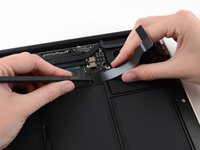
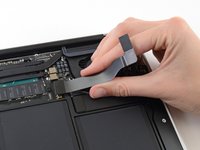





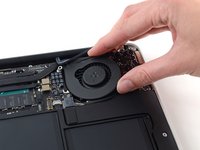
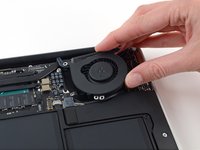



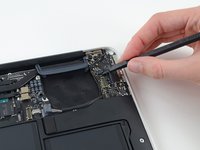
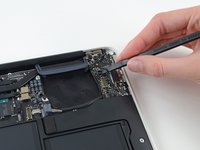


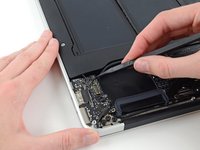
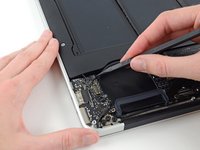



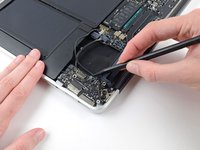
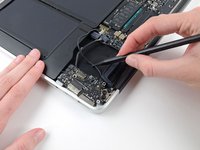








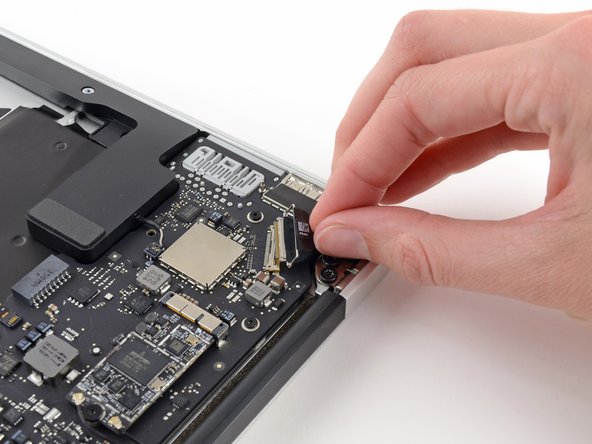




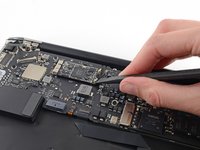
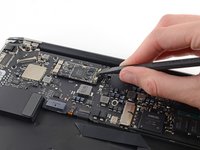


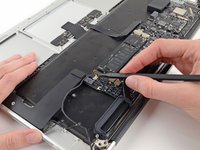
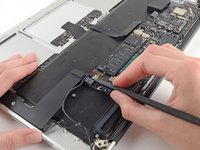


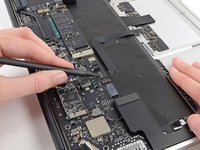
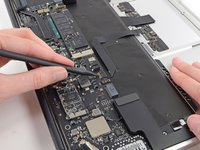



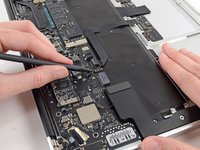
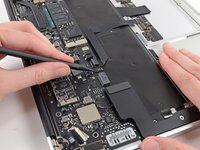
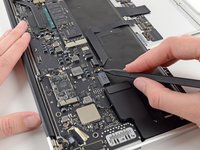







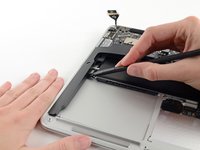
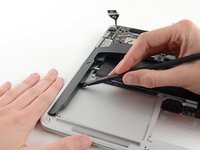
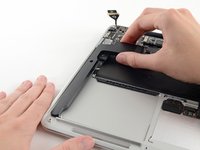


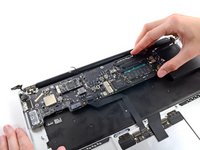
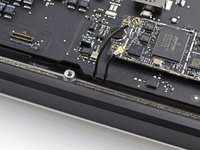




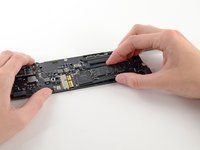



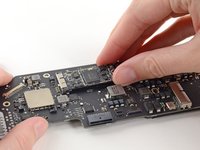
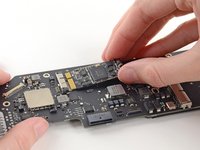



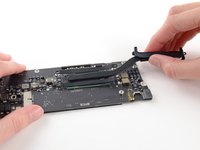
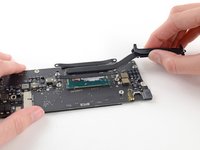



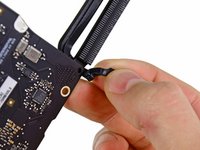
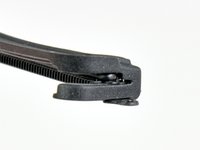
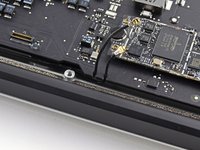


Pulling the fan cable out was terrifying but you actually just pull on the cable itself. No way to get any leverage at the connector to dislodge it. Did come out easily but like I said, scared me!
allison - Replica
Draai de schroefjes voorzichtig los en leg ze op een stabiele plek neer en let erop dat de schroefje een verschillende lengte hebben.
bwgvanderveer - Replica
I thought I could replace my 256 Gb SSD with 512? regards
ola m - Replica
Do you have good Test Point Voltages? It appears there are silver colored Test points on the I/O Board. I am working on a water spill and trying to troubleshoot if both the I/O board and the Logic need replaced.
andrew - Replica
It's probably not necessary but may be a little safer to completely discharge the old battery before replacing it.
Larry Smith - Replica
tell a model that was not inferior to the speed of the one in the laptop.
Thank you
ilyabuhov - Replica
Do i need to order tools separately to replace the battery i just ordered?
anne uhlir - Replica
im looking for a Logic Board for a
Apple - MacBook Air® - 13.3" Display - Intel Core i5 - 8GB Memory - 128GB Flash Storage (Latest Model) - Silver Model: MQD32LL/A
Any help is appreciated.
Jamie Comstock - Replica
P5 pentalobe screwdrivers are too big! The correct size for these screws are p4 pentalobe. P5 pentalobe was just able, with difficulty, to turn some of the screws. If the screws were at all tight, my p5 was unable to get them out, and started to strip the screws. A p4 screwdriver fit better and removed the screws with ease. (I was using high quality Wiha brand screwdrivers.)
William Skinner - Replica
I had same experience (with MacBook Air 13-inch Mid-2012) … had to get P4, which worked swimmingly
eric -
Very simple installation. The screwdriver heads were exactly what we’re needed, one head for the outside case screws, the other for the screws holding the battery in place. The computer started right up. Now to see how the battery holds up, but I have a good feeling about this!
Dennis Eaton - Replica
My P5 and the T5 worked perfectly with my early 2015 Air 13”! And it is super fast! Thank you iFixit!
Pennny Beach - Replica
The supplied kit and instructions worked perfectly!
Nikolay Andreev - Replica
Comments that the P5 pentalobe are too large are absolutely spot-on. There is no way the P5 pentalobe bit I have will work with the MacBook Air without destroying the screws. Hard target search for P4 pentalobe bit in progress…..
joemoog - Replica
Bonjour j’aimerais changer mon SSD de 128 Go pour en mettre un de 512 Go. Je ne sais pas ce qu’il faut prendre car il faut qu’il soit compatible avec le macbook air A1466. J’aurais vu un Samsung Evo 970 500 Go mais si je ne me trompe pas, il faut un adaptateur.
Merci pour votre aide.
chicco33 - Replica
oui, vous aurez besoin d’un adaptateur, pour completez le changement.
Dan -
The tool kit should include tweezers for re-inserting the battery connector.
Andre Clement - Replica
P5 pentalobe worked perfectly for me. Instructions were spot-on. Antenna connections were a bit fiddly to refit but got them in ok.
michaelquinnell - Replica
Maybe the problem some are experiencing is that the designations are confusing (blame Apple rather than iFixit). the P2 is also known as PL1. The P5 is also known as PL4. The P6 is also known as PL5. So it is possible to mistake the P6 (PL5) for the P5 (PL4), meaning it (P6-PL5) will be too big, while the P5 (PL4) will be just right. Sort of a 3 Bears explanation, but it is very confusing.
Thomas Lewis - Replica
To add to this. In searching for the P5 screwdriver to buy in UK, as far as I can tell, it is also known as
Pentalobe 1.2(mm)
also
P4 = 0.8
P6 = 1.5
Just unscrewed the back case of MacBook Air 13” mid 2011, with no problems using Pentalobe 1.2
nijafe -
I have not replaced a display on the A1369 but have done many A1466 which is a newer 13” model. They seem really similar and its not clear why one needs to remove the logic board to remove the display. The antenna cables on the A1466 dont have to rest under the logic board but can be tucked in the hinge crevice. Cant this same thing be done with the A1369?
Sean Love - Replica
Did mine today - but new battery wasnt charging. Went back in and noticed the battery connector cable was not quite 100% “seated. It was sticking out by less than a millimetre! - you need to give it quite a firm push in to get it seated properly. Otherwise - all ok .
John Brennand - Replica
Just installed on a MacBookAir6,2 (13-inch, Early 2014).
Was very easy.
New iFixit battery looks great so far:
Jonathan Cross - Replica
can you tell me which size of screwdrivers you’ve used to crack it up, please? I have the same model and size,
hawk_lpc -
Screw P5 Pentalobe 1.2
Mario Verlent - Replica
Install went flawlessly. Only challange was reattaching blue tooth antennas. Those sockets are so tiny.
Joel Sebastian - Replica
Installation was a little challenging at first because the instructions on this site did not perfectly match my model (late 2013 to early 2015).
Found this video on YouTube which described the procedure perfectly https://www.youtube.com/watch?v=Lue6lVWh...
Also the Ifixit kit I received was well put together with everything I needed and more. The calibration went perfectly and I am very pleased. Will buy again!!
Donald Niamath - Replica
Gently pulled out connector of old battery, then pressed and held the power switch for 1 minute. Unscrewed and removed the old battery. Pressed and held power switch for 1 minute again. I know from previous work that this helps drain charge from spontaneous recharging as the dielectric recovers. Gently “fine tuned” leads from new battery to connector till connector stuck out at right angle to the edge of battery. Held the battery by the edges and let the connector slide into the socket. Set the battery down and put the screws in all the way. Then checked that the connector was completely seated before tightening the screws. The laptop come on immediately and showed 98% charge and registered normal (checked in “About this Mac”. Very happy to this point. Now for calibration.
Amir Zaidi - Replica
Thank you very much for the guilde. My MBA2011 had reborn !
Billy Wong - Replica
Allow for electrostatics, otherwise you may cook components on the logicboard /motherboard (like I did with one of these!)
See great advice: Electrostatic Discharge
Fletcher Cole - Replica
… und wenn du eines von diesen wirklich kleinen Schräubchen vermisst: bevor du den Boden aufkehrst oder mit einem starken Magneten absuchst, schau mal am seitlichen (magnetischen) Ladekabelanschluss nach … ?
... and if you miss one of these really small screws: before you sweep the floor or search it with a strong magnet, take a look at the (magnetic) charging cable connection on the side … ?
Blatt - Replica
Fot All People ha ing trouble finding their SSD
DONT PRESS CMD +R + POWER
instead press
OPTION+CMD+R +POWER
I just installed Monterrey with WD black sn 770 SSD in m'y macbook air 2015
Albert - Replica
IFixit just had me submit "my story" re. fixing my MacBook Air 2013.
This repair was NOT difficult. The battery is enclosed in a plastic frame. It is NOT glued in like the newer models of Apple laptops. And unlike older laptops, the battery is not totally enclosed in a plastic housing. So once you remove the screws holding the batterie's frame, you can remove the battery.
Follow the instructions. Read the comments. Also read the comments re. installing a new battery.
Good luck. - Eric J.
ECJohansen - Replica
On the back of the laptop, notice that each screw is angled a little bit inward, aiming toward the middle of the laptop. Keep your screwdriver lined up with the screw (angled a bit outward as seen at 01:23 in the video: https://youtu.be/tToAwO6f-SY&t=83). This will help you get a good bite on the screw to get it out and avoid stripping the head of the screw.
Use the same angle when putting each screw back in. If the screw is in line with its hole it should not feel like you are fighting to screw it in. If it does, check your angle and back up a little; you should feel the screw fall into line.
Rich Garella - Replica
IFixit just had me submit "my story" re. fixing my MacBook Air 2013.
This repair was NOT difficult. The battery is enclosed in a plastic frame.
shrhh - Replica
Is it possible to change an upper case with a german keyboard for an english one?
Rogerio Pefi - Replica
if you are intending to change it to British layout you don't need to change the keyboard at all, just the keys, buy either a set of a1466 key caps ( I assume you have a 2017 MacBook Air?) or a cheap a1466 keyboard (can even be a broken one), remove the keys that are different and replace them with the other keycaps, and then set the macbook's language to British and you are set
Kai Mcpherson -